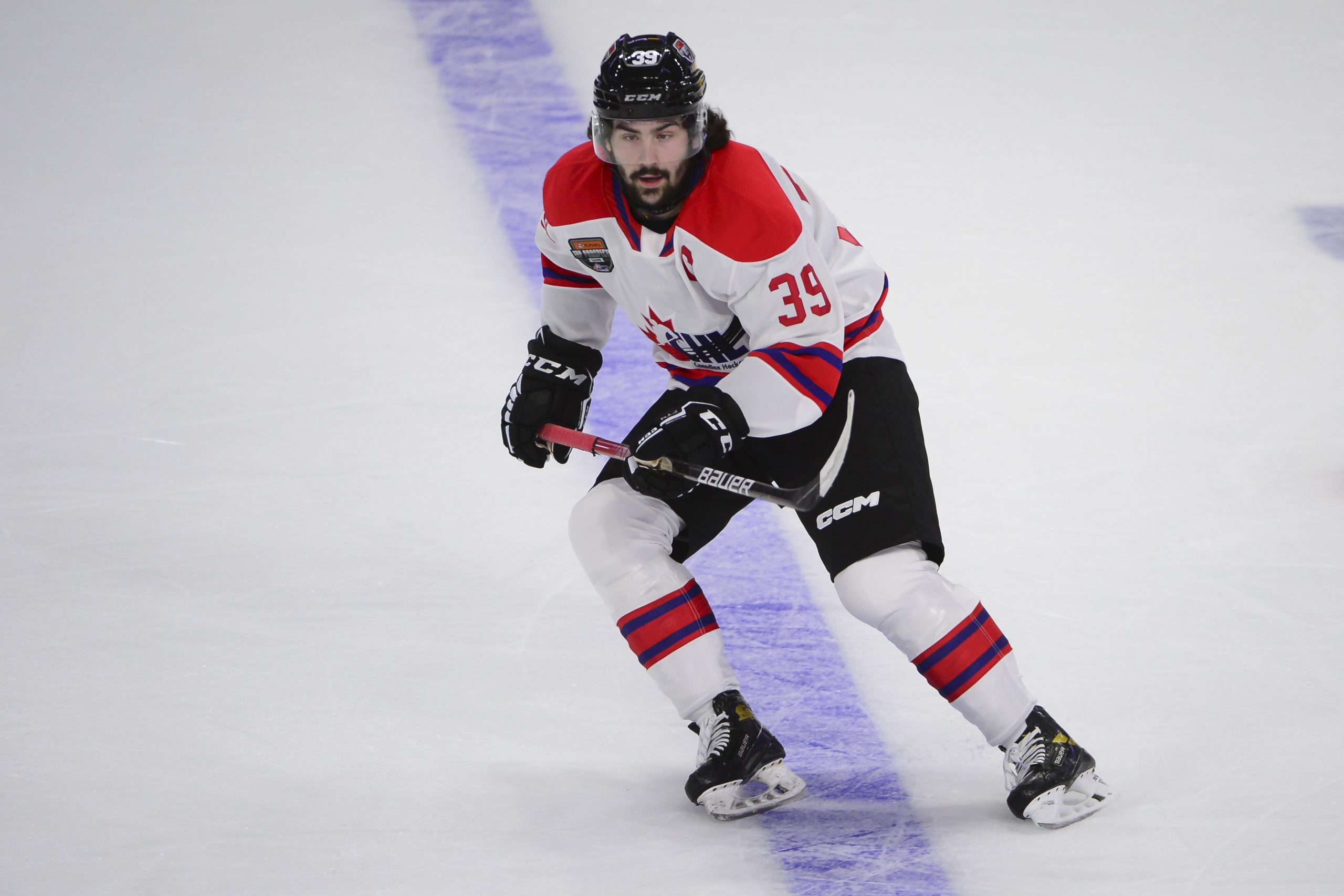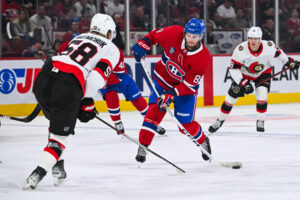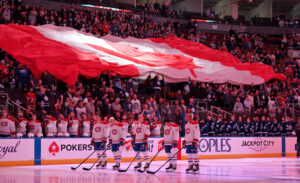Welcome back to Top Shelf Prospects, the column that brings you the next crop of professional hockey players. Each day our LWOS Prospects Writers will bring you a new player profile or topical article in the lead-up to the 2023 NHL Draft. Be sure to bookmark the site, follow Ben Kerr, Kyle Pereira and Frederik Frandson on Twitter, and spread the word for the site that will bring you analytical and critical profiles and scouting reports! Last Word On Hockey Prospects is your new headquarters for everything “NHL Draft”! Today we bring you our Colby Barlow Scouting Report.

The 2023 NHL draft class is a loaded one. From the top with Connor Bedard and Adam Fantilli, it is arguably one of the best classes in recent memory. One player who has gotten some attention as of late is OHL star, Colby Barlow.
Colby Barlow Scouting Report
Left Wing — shoots Left
Born February 14th, 2005 — Orillia, Ontario
Height 6’1″ — Weight 190 lbs [185 cm / 86 kg]
Background
Barlow, born February 14th, 2005 in Orillia, Ontario, is a left winger for the Owen Sound Attack of the OHL. The 18-year-old forward stands at 6’1” and 187 pounds, possessing a solid frame. Over the last two seasons, Barlow’s goal-scoring has been on full display with the Attack. In total, he has scored 76 goals in 118 OHL games. This season, Barlow has potted 46 goals and 33 assists for 79 points in 59 regular season games. The Attack lost in a four-game sweep to the London Knights in the very first round. Barlow had three goals in the four-game series.
With the goal-scoring, plus the added bonus of wearing the “C” on his jersey, Barlow has been ranked between seventh and 32nd by various analysts and sites, but largely lands in the seventh to 15th range. He has been ranked seventh by Craig Button, eighth by The Hockey News and Bob McKenzie, ninth by SportsNet, 10th by Daily Faceoff, 11th by Recruit Scouting and Draft Prospects Hockey, 15th by McKeen’s Hockey, 16th by Elite Prospects and FCHockey, 22nd by DobberProspects, and 32nd by Smaht Scouting.
Colby Barlow Deep Dive
Despite the really high goal-scoring, which generally gets a lot of love, there is still some discrepancy between analysts. Is that due to Barlow being a one-sided player? Or is there more to the story?
Barlow’s Skating
Barlow is not the greatest skater. His speed is above average, and he doesn’t possess that extra gear to truly burn past defenders with the puck or recover quickly away from the puck when play changes directions. However, he isn’t slow, either. He can more than keep up with the play. Additionally, he does have some power in his first few strides, which allows him to reach his top speed quickly. Not only that, his stride mechanics are really strong, which will be something NHL skating coaches should be happy to work with.
The biggest issue with Barlow’s skating is his edge work. While he has shown at times some pretty incredible edge work, like the ability to walk the blue line when he receives the puck up at the point while covering for a teammate, it is few and far between. There are times throughout a game where Barlow gets caught behind the play when possession changes hands. He doesn’t seem to consistently pull off tight turns with regularity, and he can lose speed in the process. However, to go back to his solid stride mechanics and powerful initial strides, he can and should be coached up in that regard.
Offensive Abilities
Looking at the stats, Barlow looks like a pure goal-scorer. Over 40 goals this season, and a considerable amount more goals than assists in his OHL career? Must be a pure sniper. While that may seem like the case, and Barlow certainly likes to shoot, there is more than meets the eye. The reason for Barlow’s goal-scoring is more of a testament to his incredibly high IQ and willingness to battle at net-front. With his big frame, he wins a lot of tips and races to rebounds.
As for his playmaking, it certainly isn’t flashy. He doesn’t make eye-opening passes with regularity, nor does he flash incredible creativity or stickhandling. But what he does do is locate the smart passes to maintain possession, and he does a very good job of connecting on those passes. And, even still, he can flash the fancy pass or two at times. It isn’t the prettiest, but he can certainly make plays happen.
Shooting Ability
As this is his strongest trait in the offensive zone, let’s start with his shooting. His shot possesses a ton of power. Barlow can really unload a bomb when given the time and space to truly load up. Additionally, if you give him too much space, he will surely make you pay. However, he can, at times, lack accuracy. Let’s look at some tracked stats.
In three tracked games, Barlow attempted 15 shots, with six hitting the net, to go along with two goals. Both goals were on the powerplay, and both were off rebounds. Additionally, all six shots on goal came with the man advantage. What that means is, on seven shots at even-strength, not a single one hit the net. Those shots either missed wide or were blocked. Now, of those seven even-strength shots, three came from high-danger. That’s a testament to how often he attacks those high-danger areas.
Playmaking Ability
Now, looking at Barlow’s playmaking ability, we see the poise and possession-dominant game of his. While he loves attacking high-danger without the puck, setting up shop for his teammates to find him, he usually does not target high danger with his passes. In total, in those three aforementioned games, he attempted 41 offensive zone passes, with 34 completions (82.93% rate). Of those, three were aimed at high-danger (zero completed). That’s 7.32% of his total passes aimed at high-danger.
To break it down even further, 17 of those 41 attempts came at even-strength, while 22 came on the power play, and two on the penalty kill. Of the 17 even-strength pass attempts, 13 were completed. Only one pass was aimed at high-danger, while 15 were aimed at low-danger (13 completed). To put it simply, Barlow looks to keep play moving, not push the pace through his passes.
Colby Barlow’s Transitional Abilities
When it comes to Barlow’s transitional abilities, there may be some eye-test concerns. His passing doesn’t seem to be the most effective, based on the offensive numbers. Looking at his skating, he isn’t the fastest, which means he can’t dominate the way guys like Zach Benson or Bedard do. Then, finally, he doesn’t possess the creativity or stickhandling, as mentioned above, as some other high end talents. So, how effective can he truly be?
Diving Deeper Into The Transitional Numbers
Well, when it comes to exiting the defensive zone, Barlow is pretty heavily relied upon. He was involved directly on 21 zone exit attempts and had 26 defensive zone touches, all at even-strength. He successfully cleared the puck, with possession, on 66.67% of those attempts (14 controlled exits).
As for entering the offensive zone, he was less involved. Barlow was directly involved in 17 zone entry attempts at even-strength. Of those attempts, he successfully entered the offensive zone, with possession, on just 52.94% of them (nine controlled entries).
On the penalty kill, he had a controlled exit rate of 25%, while successfully dumping the puck out on 37.5% of them. On the powerplay, he had a controlled entry rate of 100%, but only was involved on two total entry attempts.
Barlow’s Defensive Zone Play
When a player has the type of goal-scoring Barlow does, there isn’t always an expectation of strong defensive zone play. Then, one can look at the wide range of where he is ranked, and can maybe think that the rankings that are lower on Barlow weigh more on his potentially poor defensive game. But that is absolutely not the case. Barlow is a high-energy player that has a seemingly endless motor. He hardly ever takes a shift off. Barlow is a willing forechecker, although he isn’t the most efficient (just two forced turnovers total in the three games, compared to Bedard’s seven in just two games at even-strength). He also back checks very hard as well.
When it comes to defending in zone, he displays a maturity beyond his years. Barlow possesses an active stick and incredible anticipation to intercept passes and turn the puck up ice very quickly. He is also more than willing to defend low and against the cycle. Barlow isn’t afraid to block shots, battle for pucks along the boards, or finish his checks. He is a handful for any opponent in his own end.
Colby Barlow’s Potential
When it comes to Barlow’s potential, there are mixed feelings. With his somewhat one-sided offensive game, due mostly to the lack of creativity and pace-pushing, can he truly lead his own line? It’s tough to say. But, he does possess a power-forward style, with a strong nose for the net, and a complete 200-foot game, that can pair well with a superstar.
As he continues to fine-tune his shot and build his skating, transition game, and playmaking, Barlow could further push his ceiling. But as of now, he looks like someone who projects as a top-six winger with 40 to 50-point upside, playing alongside a star (Clayton Keller, perhaps?).
NHL Comparison
Based on style only and not on projection, there are two players that come to mind when watching Barlow: Mark Stone and Ondrej Palat. Stone is a solid 200-foot winger with incredible goal-scoring ability and a high IQ. He also possesses a willingness to play the physical game, and has size to hold up.
Meanwhile, Palat is a veteran who plays so well within the finer details of the game, that when paired with a star, he thrives. His physical game and overall complete style has allowed him to carve out a long and successful career alongside players like Steven Stamkos, Nikita Kucherov and Jack Hughes. Barlow’s game will still need some work, but if he were to be an NHL player, he seemingly would end up playing a similar style to those two.
Highlights
Tracked Stats from Kyle Pereira
Raw stats via Elite Prospects
Main photo by: Anne-Marie Sorvin-USA TODAY Sports






